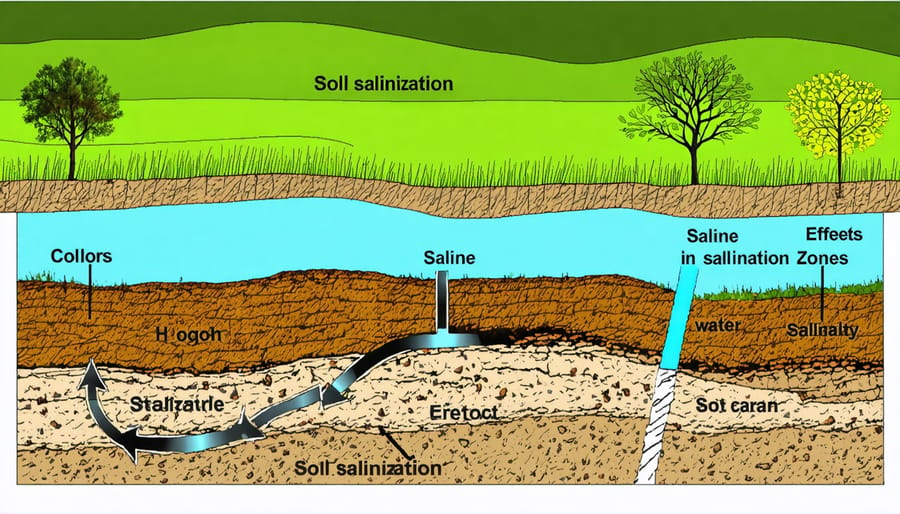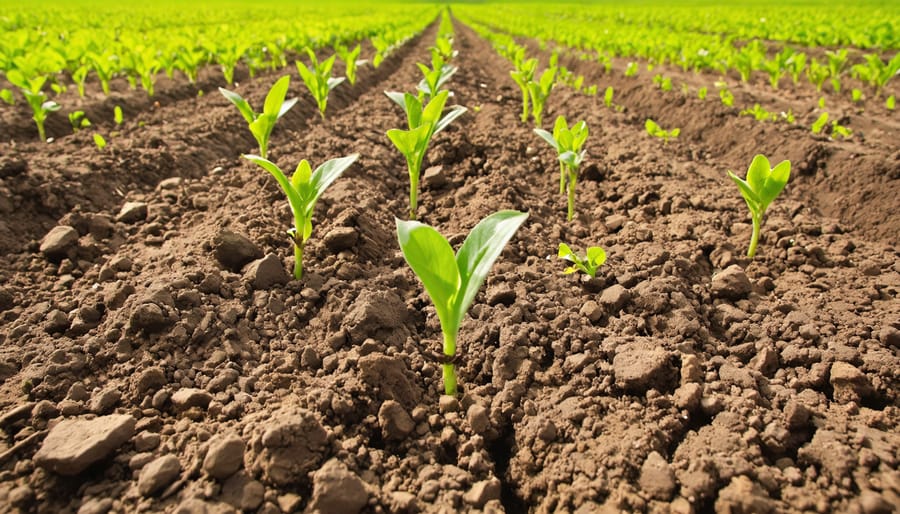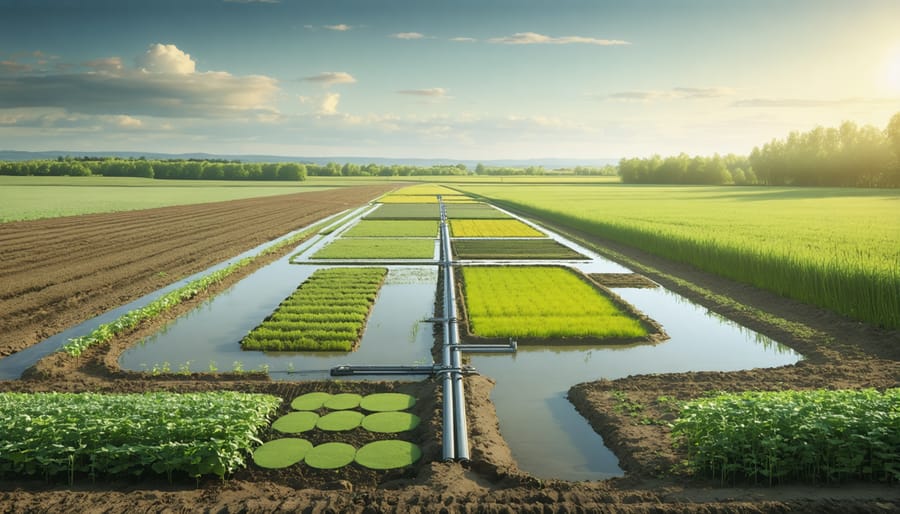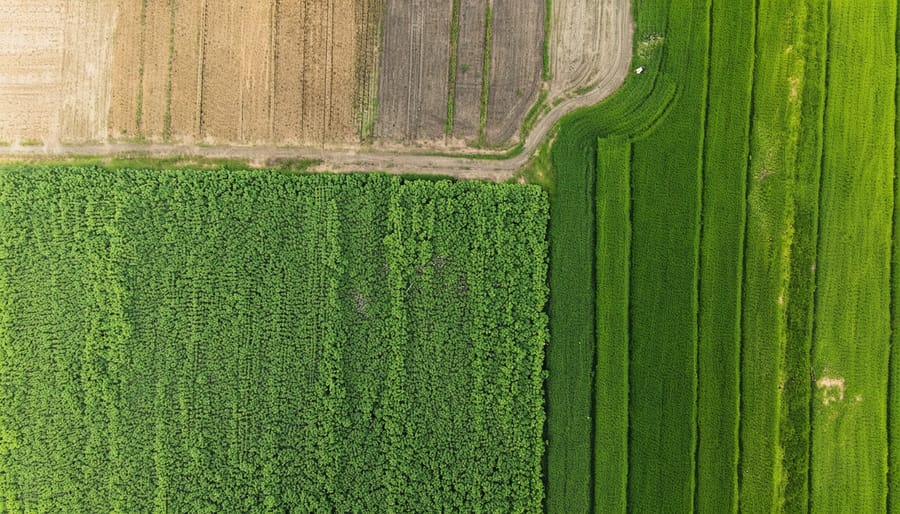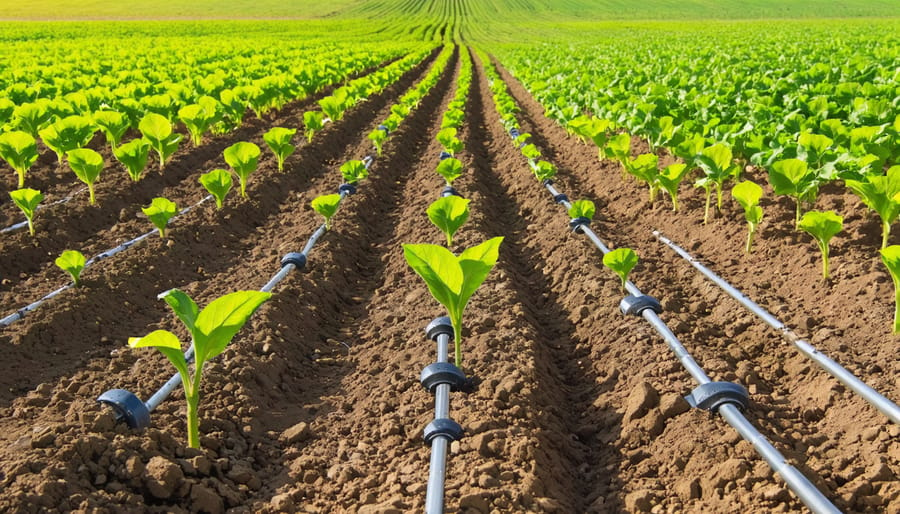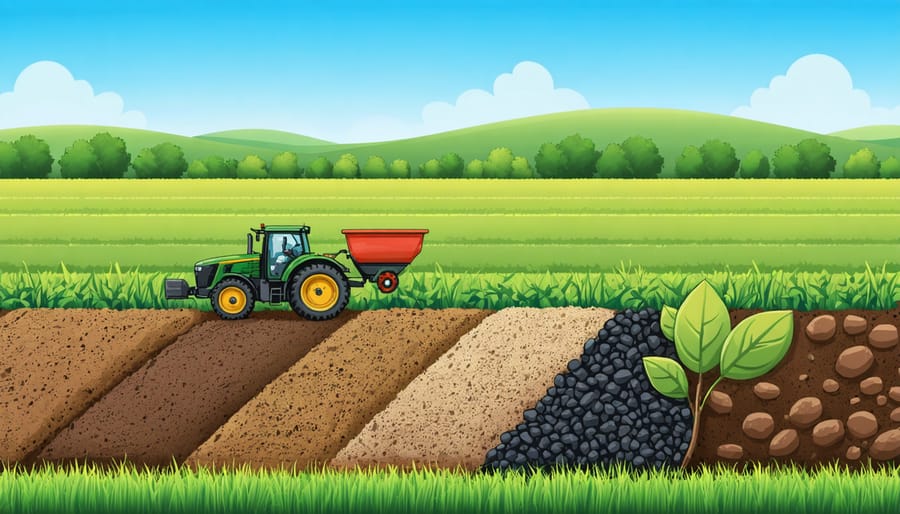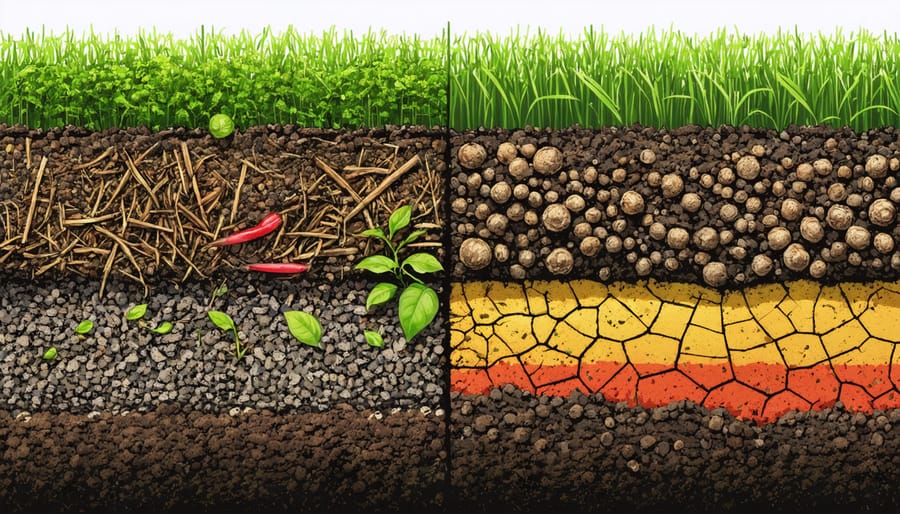Visualizing soil salinization transforms how we understand and combat one of Western Canada’s most pressing agricultural challenges. Every year, Canadian farmers lose millions in crop yields to salt-affected soils, but understanding the visual patterns of salinization offers a powerful first step toward recovery. Through detailed soil salinization diagrams, we can trace how dissolved salts move through soil profiles, identify early warning signs, and implement targeted solutions before crop damage occurs. These visual tools have become essential for Alberta’s agricultural communities, where more than 1.6 million hectares of farmland face salinity challenges. By mastering the interpretation of these diagrams, farmers and agricultural professionals can detect salt accumulation patterns, understand groundwater movement, and develop precise management strategies that protect both soil health and crop productivity. Whether you’re dealing with primary salinization from natural processes or secondary salinization from irrigation practices, these visual guides serve as your roadmap to sustainable soil management.
Understanding the Soil Salinization Process
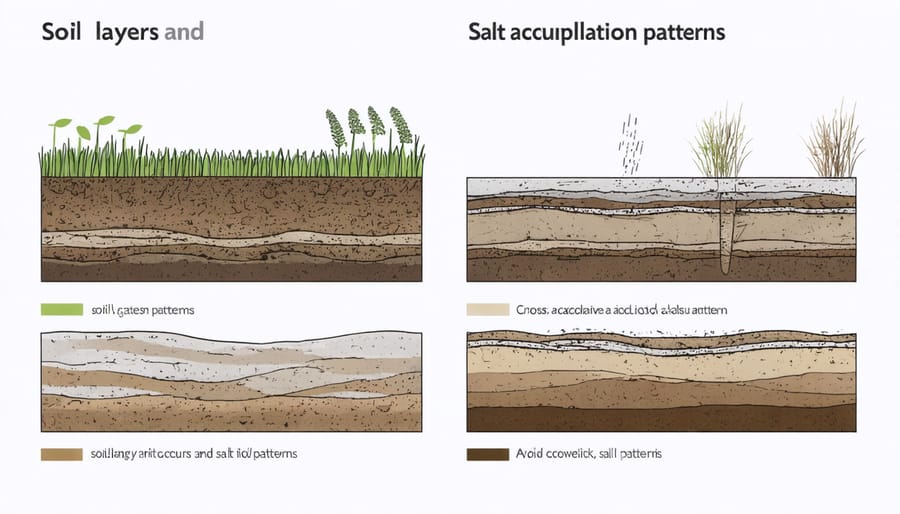
Natural vs. Human-Induced Salinization
In nature, salt accumulation occurs gradually through weathering of parent materials and the movement of groundwater. Prairie regions, like those in southern Alberta, have naturally occurring salt deposits from ancient sea beds. These salts slowly rise to the surface through capillary action, especially in areas with high water tables.
However, human activities can significantly accelerate this process. Modern farming practices, while essential for food production, can contribute to salinization when not properly managed. Irrigation without adequate drainage systems is one of the primary culprits. When we add water to crops but don’t ensure proper drainage, the water table rises, bringing dissolved salts to the root zone.
Land clearing and the shift from deep-rooted perennial vegetation to annual crops has also impacted salt distribution in our soils. Native plants, like prairie grasses, helped maintain a natural balance by controlling groundwater levels. The removal of these plants can disrupt this balance, leading to increased salt concentration in topsoil.
Here in Alberta, we’ve seen both processes at work. For instance, the Palliser Triangle region experiences natural salt deposits, but irrigation development has intensified salinization in some areas. Understanding these differences helps us develop targeted solutions – while we can’t control natural processes, we can adjust our farming practices to minimize human-induced salinization.
Critical Zones in Your Field
In Alberta’s diverse agricultural landscape, certain areas are particularly vulnerable to soil salinization. These critical zones typically occur in three main landscape positions: depressions, slope positions where groundwater discharge occurs, and areas with restricted drainage.
Look for white salt crusts forming in field depressions during dry periods – these are your first warning signs. The most susceptible areas often form in a ring pattern around sloughs or in fan-shaped patterns at the base of hills. These patterns appear because salt-laden groundwater moves from higher to lower elevations, carrying dissolved salts with it.
Pay special attention to areas where you notice patchy crop growth or where certain weeds like kochia or foxtail barley thrive. These indicator plants often signal developing salinity issues before visible salt crusts appear. In many cases, the most severe salinization occurs in the transition zones between well-drained uplands and poorly drained lowlands.
Using elevation maps of your field, identify areas where water naturally accumulates. These spots, especially if they sit above shallow water tables (within 2 metres of the surface), require close monitoring. Consider installing observation wells in these locations to track water table fluctuations and salt movement patterns.
Remember, early identification of these critical zones allows for targeted management strategies, potentially preventing the spread of salinity to surrounding areas.
Reading Your Soil’s Warning Signs
Visual Assessment Guide
When assessing your fields for salt-affected areas, start by looking for telltale plant patterns. Watch for patches where crops grow poorly or not at all, surrounded by concentric rings of progressively healthier vegetation. These “bull’s-eye” patterns are classic indicators of saline seeps.
In early spring, look for white crusting on the soil surface, particularly in low-lying areas or where water tends to pool. These salt crusts often appear as a fine, powder-like coating that becomes more visible as the soil dries. During wet conditions, salt-affected areas may appear darker and remain wet longer than surrounding soil.
Pay attention to weed species that thrive in your fields. Salt-tolerant plants like kochia, foxtail barley, and wild barley often dominate saline areas. The presence of these indicator plants can help you identify problem areas before they become severe.
For a more detailed assessment, examine soil structure. Saline soils often develop a crusty surface layer and may feel greasy or slick when wet. In severe cases, you might notice a columnar structure just below the surface, where soil breaks into distinct vertical columns.
Document these visual indicators with photographs and field notes throughout the growing season. This documentation helps track changes over time and assists in developing targeted management strategies for affected areas.
Remember that early detection through regular visual assessment allows for more effective and economical management of soil salinity issues.

Soil Testing Protocol
To accurately assess soil salinity levels, follow these field-tested soil salinity testing methods developed for Canadian prairie conditions. Begin by collecting samples from multiple locations within your field, focusing on both affected and unaffected areas for comparison. Take samples at depths of 0-15 cm, 15-30 cm, and 30-60 cm to create a comprehensive soil profile.
For reliable results, collect samples during early spring or late fall when soil moisture levels are stable. Avoid sampling immediately after rainfall or irrigation. Use clean, plastic sampling tools to prevent contamination, and store samples in sealed plastic bags to maintain moisture content.
Label each sample with location coordinates, depth, and date. Send samples to an accredited soil testing laboratory for electrical conductivity (EC) analysis. Results are typically reported in deciSiemens per metre (dS/m). Generally, readings above 4 dS/m indicate saline conditions that may affect crop growth.
Keep detailed records of your test results to track changes over time and evaluate the effectiveness of your management strategies. Consider mapping your results to visualize salinity patterns across your field.
Prevention and Management Solutions
Water Management Techniques
Effective water management is crucial for preventing soil salinization in Alberta’s agricultural lands. Implementing smart irrigation practices can significantly reduce salt accumulation while maintaining crop productivity.
Subsurface drip irrigation has proven particularly effective for Alberta farmers, delivering water directly to crop root zones while minimizing surface evaporation. This method typically reduces salt buildup by up to 40% compared to traditional flood irrigation systems. Installing soil moisture sensors at different depths helps monitor water distribution and prevents over-irrigation, a common cause of salt accumulation.
Proper drainage is equally important. Installing tile drainage systems at appropriate depths (usually 1.5 to 2 metres) helps remove excess water and dissolved salts from the root zone. Many successful Alberta operations combine these systems with interceptor drains along field boundaries to prevent saline seepage from adjacent areas.
Timing irrigation according to crop needs rather than fixed schedules is essential. Early morning or evening irrigation reduces evaporation losses, while avoiding irrigation during periods of high winds prevents uneven water distribution. Consider implementing automated irrigation systems that adjust water application based on real-time weather data and soil moisture readings.
Regular maintenance of irrigation systems, including checking for leaks and cleaning filters, ensures uniform water distribution and prevents localized salt buildup. Additionally, maintaining proper field leveling helps prevent water ponding, which can lead to concentrated salt deposits in low-lying areas.
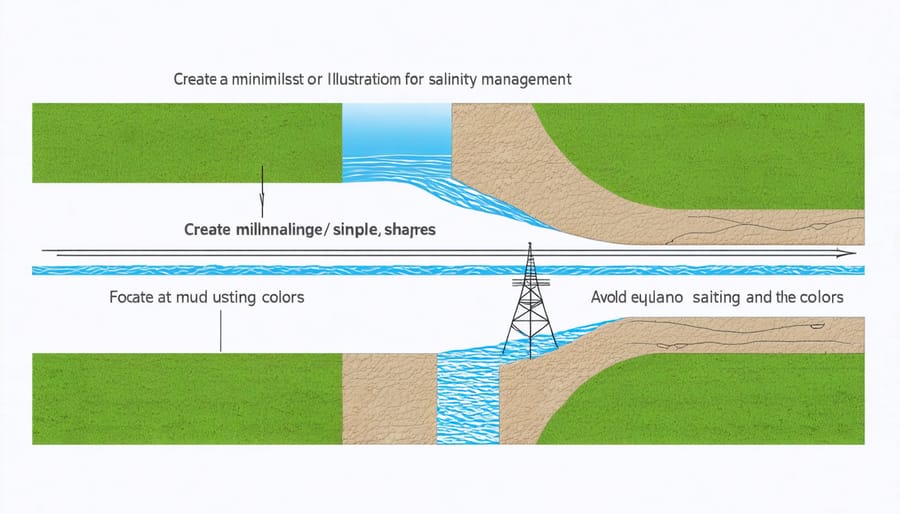
Salt-Tolerant Crop Selection
Selecting the right crops for salt-affected soils is crucial for maintaining profitable farming operations in Alberta. Several drought-resistant crops also show excellent salt tolerance, making them ideal choices for affected areas.
Barley leads the pack as one of the most salt-tolerant grain crops, capable of thriving in soils with electrical conductivity (EC) up to 8 dS/m. Canola, a staple in Alberta’s agricultural landscape, demonstrates moderate salt tolerance and can perform well in slightly saline conditions up to 6 dS/m.
For forage production, tall wheatgrass and salt-tolerant alfalfa varieties have proven successful in many Canadian prairie regions. These crops not only withstand saline conditions but also help improve soil structure through their extensive root systems.
When selecting crops, consider implementing a rotation system that includes both salt-tolerant and soil-improving species. Start with more tolerant varieties in heavily affected areas and gradually introduce less tolerant crops as soil conditions improve.
Local success stories show that salt-affected fields can remain productive with proper crop selection. The key is matching crop tolerance levels with your soil’s salinity measurements and considering seasonal variations in salt concentration.
Soil Amendment Strategies
For Alberta’s saline soils, a combination of organic and chemical amendments can significantly improve soil structure and reduce salt concentrations. Organic materials like compost, straw, and green manure enhance soil structure while promoting beneficial microbial activity. These amendments are particularly effective when integrated with proper soil moisture management practices.
Gypsum (calcium sulfate) remains one of the most effective chemical amendments, helping displace sodium ions and improve soil aggregation. For moderately saline soils, application rates of 2-4 tonnes per hectare have shown positive results across Alberta farms. Sulfur-based amendments can also be beneficial, particularly in alkaline soils common to the prairie region.
Local success stories demonstrate the effectiveness of combining amendments with cover cropping. The Lethbridge Research Centre documented a 40% reduction in surface soil salinity over three years using a rotation of salt-tolerant alfalfa and the strategic application of gypsum.
When selecting amendments, consider your soil test results and local conditions. Start with small test plots to determine the most effective combination for your specific situation. Remember that amendment strategies work best as part of a comprehensive management plan that includes proper drainage and irrigation practices.
Success Story: Local Farm Transformation
The Smith family farm, located just outside of Lethbridge, Alberta, stands as a testament to successful soil salinity management. In 2015, third-generation farmer James Smith noticed white crusting on approximately 40 hectares of his cropland, along with poor crop emergence and stunted growth in his canola fields. Soil tests confirmed his suspicions: the electrical conductivity readings showed moderate to severe salinization.
Rather than accepting reduced yields, Smith developed a comprehensive management plan in partnership with local agricultural extension services. He first implemented a targeted drainage system to lower the water table and installed soil moisture monitors to optimize irrigation scheduling. The next crucial step involved introducing salt-tolerant crops in affected areas, starting with barley and eventually transitioning to salt-tolerant alfalfa varieties.
Within three years, the results were remarkable. Soil tests showed a 30% reduction in salt concentrations in the most affected areas. Crop yields increased by 25% compared to pre-management levels, and previously barren patches began supporting healthy plant growth. The success prompted neighboring farmers to adopt similar strategies.
“The key was patience and consistent monitoring,” Smith explains. “We didn’t expect overnight results, but by following the management plan and adjusting as needed, we’ve turned things around.” The farm now serves as a demonstration site for local agricultural workshops, where Smith shares his experience with other farmers facing similar challenges.
The Smith family’s success story highlights the importance of early detection, systematic management approaches, and community knowledge sharing in addressing soil salinization challenges in Alberta’s agricultural landscape.
Managing soil salinization requires a proactive and community-driven approach. By understanding the visual indicators and implementing appropriate management strategies, you can protect your land’s productivity for generations to come. Remember to regularly monitor your soil conditions, maintain proper drainage systems, and consider salt-tolerant crops when necessary.
For additional support, reach out to your local Agricultural Fieldman or contact Alberta Agriculture and Irrigation’s Ag-Info Centre. These experts can provide soil testing services, detailed management plans, and access to the latest research on salinity management. Many regional agricultural societies also offer workshops and field days where you can connect with other farmers facing similar challenges.
Take advantage of government programs supporting soil health initiatives, including cost-sharing opportunities for drainage improvements and sustainable agriculture practices. By working together and sharing knowledge, our farming community can effectively combat soil salinization while maintaining productive and sustainable agricultural operations.
Remember, early intervention is key. Start implementing these management strategies today to ensure healthy soils for tomorrow’s harvest.

